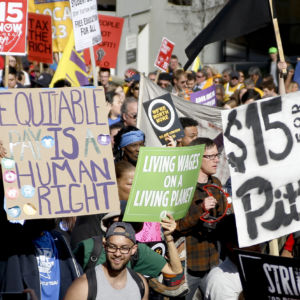California became the first state to increase its minimum wage to $15 an hour, but that could mean the loss of hundreds of thousands of jobs, warned a report Thursday.
The $15 minimum wage has become a leading issue on the left in recent years. Seattle was followed by dozens of cities and a couple states when it first enacted the policy in June 2014. But alongside the victories is a fierce political debate on whether the policy actually helps – with some arguing it could hurt the very people it’s meant to benefit.
Those in support of the policy believe it could help low-wage workers escape poverty which could result in a general boost to the economy. Critics contest that raising the minimum wage increases the costs of labor which could limit job opportunities.
California and New York both became the first two states to enact the $15 minimum wage within hours of each other in April 2016. Both laws are designed to phase in the policy over a handful of years to mitigate economic problems. The Employment Policies Institute (EPI), a conservative research nonprofit, found that California could lose 400,000 jobs when the policy goes fully into effect by 2022.
“The simulations suggest that the $15.00 minimum could cause a loss of about 400,000 jobs in California,” the report states. “The job loss is not spread evenly. Slightly more than one-half of the job loss is projected to be in two industries: accommodation and food services, and retail trade.”
Trinity University Prof. David Macpherson and Miami University Prof. William Even conducted the study which also compared different counties and past minimum wage trends in the state. Looking at how the statewide workforce has reacted to earlier minimum wage increases provides some evidence on what future increases might do.
These job losses represent 4.1 percent of employment in the studied California counties. The most populated counties will see the largest number of workers losing their jobs, while smaller counties will see a larger percentage of their workforce decline.
Economists and other experts have come to various conclusions on what the impact of the policy actually is. Some have suggested the potential downsides will be marginal compared to the benefits – while others have found the negative impact could be severe, especially for young and low-skilled workers.
The Fight for $15 movement has been at the forefront of the minimum wage debate since it started in 2012. The movement has utilized protests and media campaigns to advocate for the policy. The Service Employees International Union (SEIU) has been the primary financial backer of the movement over the years.
The University of Washington reignited the minimum wage debate June 26 when it found the increase could hurt workers in Seattle. The city is scheduled to reach $15 an hour at the start of next year with the law including a phase-in period. The study found workers are having their hours reduced at a rate that exceeds the increased wages.
The University of California, Berkeley, released a report a week prior which found the citywide increase helped to increase wages while having little impact on employment. Seattle city officials asked for both studies to examine the impact the policy was having while it got phased in.

